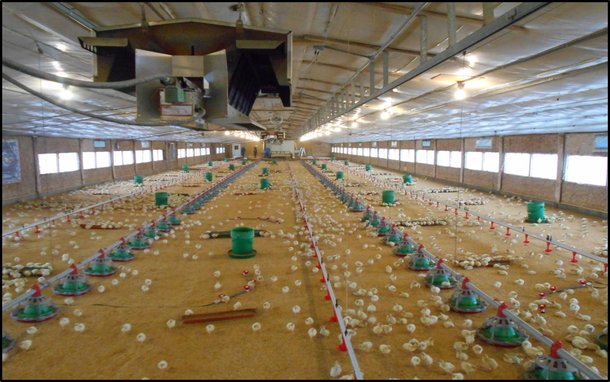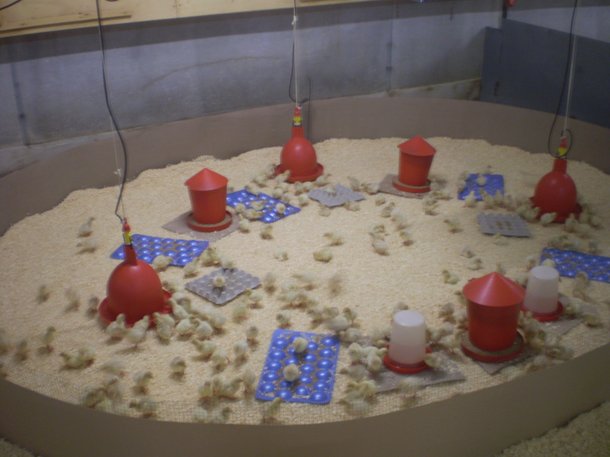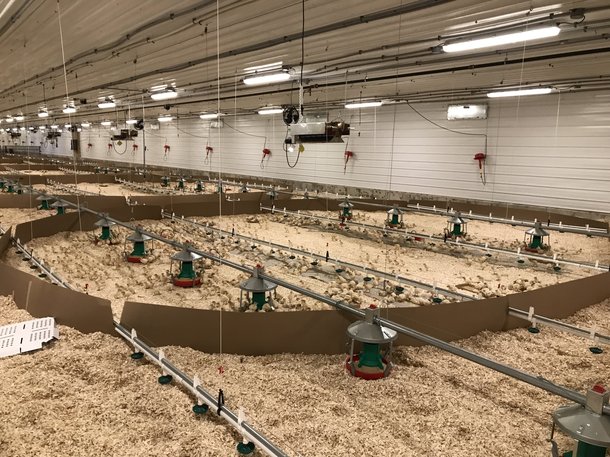Brooder house set up
Before poults are even scheduled to arrive on your farm, it is important to consider which type of brooder layout you will use as well as the equipment needed inside the brooder house. Use this section to help with your long-term planning of brooding set up before preparing for placement.
No matter your brooder layout choice, ensure your barn is set up to properly manage environmental controls.
Click here to learn more about managing ventilation and gases.
Click here to learn more about temperatures in the brooder house.
Once you have set up your brooder house, you are now ready to prepare for placement.
Equipment needs
Regardless of your set up, we recommend that you provide a sufficient amount of feeders and drinkers during the first week of brooding. Feeders and drinkers should be placed at birds level so they are easily accessible.
| Age | Number of birds per bell drinker | Number of birds per nipple drinker | Number of birds per feeder |
|---|---|---|---|
| Poults (0-6 weeks) | 90-110 | 30-40 | 50-70 |
Note: These guidelines are averages of data provided by various equipment manufacturers. Refer to the specific guidelines made by the manufacturer of your specific system for the most accurate recommendation.
Brooder layout types
Whole room brooding (recommended)
Pros: Less labor intensive as there is no need to remove the rings and transition to a whole room set up once the birds are older. This set up is also a more efficient use of heaters.
Cons: Can take some extra time to set up if this is a new type of layout for you
Whole room brooding is defined as brooding turkey poults without the use of rings to confine them under a single heat source. This style of set-up is highly recommended by Hybrid experts.
- Follow the feeder and drinker set up recommendations above.
- Check maintenance on all brooder stoves at least three days before poult arrival.
- Thoroughly clean and pilot, burner orifices, and main burner tubes. Repair or replace bad thermo-couples and stove controls at this time.

Conventional ring brooding
Pros: Useful in rooms with non-uniform temperature, such as buildings with air drafts or a lack of heating power.
Cons: More labor intensive and more costly in terms of fuel use after the birds are released from the rings.
In ring brooding, poults are kept close to the center of the stove, and brood ring edge temperatures are cooler to allow poults to find their comfort zone.
- Form brooder rings into a circular shape approx 12-14ft (3.5m - 4.5m) in diameter to avoid poults piling in corners. Approx 300-400 poults should be placed per stove.
- Level the bedding in the brooder rings.
- Place feed pans at the edge of the brooder stove, similar to the spokes of a wheel.
- Feed pans should be placed inside the ring prior to poult arrival. Approx 300 linear inches (7.5m) of feed space should be available.
- Feed pans should be kept full and free of litter and other debris.
- Supplemental drinkers are typically used as stand-alone or in conjunction with nipple style drinkers.
- Poults should remain in the rings until days 6-7. At that time, the brood rings can be removed. Supplemental feeders and drinkers can be slowly removed over the next 3-5 days to allow birds to transition to the automatic feeders and drinkers.

Large ring brooding
Pros: Much like with ring brooding, large ring brooding is useful in rooms with non-uniform temperature, such as buildings with air drafts or a lack of heating power.
Cons: This set up also requires an increased amount of labor for set up and is more costly in terms of fuel use after the birds are released from the rings.
Large ring brooding is a combination of conventional and whole room brooding. It utilizes the spot heat of radiant stoves, which provides a central focal point for the rings, but utilizes a larger brood area.
- Typically the ring is set up for 800 to 3,500 or more poults.
- Check maintenance on all brooder stoves at least three days before poult arrival.
- Thoroughly clean and pilot, burner orifices, and main burner tubes. Repair or replace bad thermo-couples and stove controls at this time.

